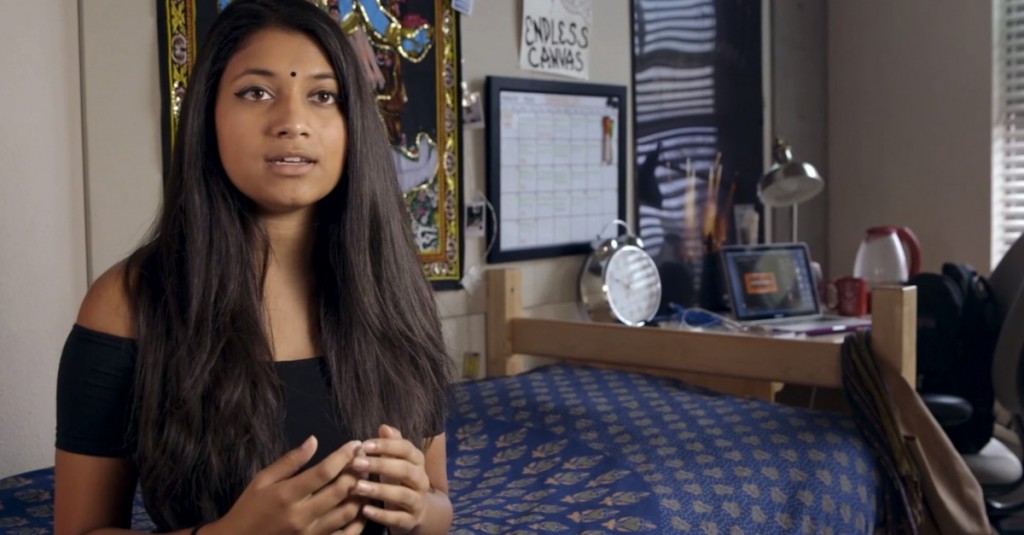Rebecca Dharmapalan's parents always called her a rebel without a cause.
Growing up in Oakland, California — the birthplace of the Black Panther Movement, parts of the Free Speech and Disability Rights Movements, and more recent movements like Occupy Oakland — she was constantly surrounded by an activist culture, but wasn't sure where to jump in.
But at age 16, the rebel finally found her cause: fighting the commercial sexual exploitation of children in her community.
Approximately 80% of reported human trafficking cases in the state of California occur in just the Bay Area, Los Angeles and San Diego alone. Oakland's underage sex market specifically is burgeoning, and Dharmapalan has witnessed it firsthand — some of her friends have been caught up in the industry. Approximately 300,000 children in the United States are at risk.
Dharmapalan knew she wanted to make a difference; the only question was how. After becoming involved in the digital media department at the Oakland School of the Arts, she produced International Boulevard, a documentary focused on commercially sexually exploited children (CSEC) in Oakland, to spread awareness on the issue.
"
I decided to use art as a means of exploring activism
I decided to use art as a means of exploring activism," Dharmapalan, now 19, tells Mashable. "I didn't realize there were so many people in Oakland using art as a way of expressing their changemaking, so I figured I'd try it out."
The film took her and her film partner only a month to put together, but it was soon winning awards at various film festivals, bringing a local perspective of a larger issue to a global audience.
"Looking back, I understand now that the more festivals I submitted to, the wider the range of people who saw the film around the world," she says. "It just opens it up to a whole different community of people."
One of those festivals was the 2014 Adobe Youth Voices (AYV) Awards, part of the Adobe Foundation's wider initiative to train and inspire youth in schools around the world to create media for social impact. International Boulevard took second place in last year's competition.
"What's really incredible about the stories we receive is that they're very authentic," Patricia Cogley, senior program manager for Adobe Youth Voices, tells Mashable. "In Rebecca's story, she identifies a social issue, but it's really one that she has to experience by living in the city she lives in. She has a personal reason for this cause."
AYV is trying to support and equip young people like Dharmapalan with the means to use digital media to address important causes, such as the environment and human rights. Cogley says these skills are incredibly important to teach.
"Young people today are often in environments that don't encourage creativity, whereas the world at work today is totally reliant on creativity.
We often talk about how the jobs of the future are the ones that we can't describe yet
We often talk about how the jobs of the future are the ones that we can't describe yet, so it's critical that young people have ... these skills," Cogley says.
These creative skills often lead to wider impact. Dharmapalan, for example, wanted to explore the issue of CSEC beyond just awareness; she wanted to incorporate prevention and direct action. Since her film began receiving attention, she has helped set up a citywide billboard campaign, helped establish a required class for middle school students in the Oakland Unified School District to learn about the issue (International Boulevard is part of the curriculum) and partnered with hospitals to create protocols for doctors who help victims and survivors for of sex trafficking.
Submissions for the fourth annual AYV Awards are now open for young people between the ages of 13 and 19 in five categories: documentary, animation, narrative, visual composition and venture. Cogley says the judges are looking out for how participants describe their ideas, why they believe they should be the ones to lead a project and how they'll use tools in creative ways. It ultimately comes down to inspiration, innovation and feasibility.
Reminder! #AYVA2015 kicked off this month. Get those submissions in #today http://t.co/QrYes2UgGw pic.twitter.com/HRp7wrs7r9
— Adobe Youth Voices (@adobeyv) February 26, 2015
"We really see young people as powerful agents of change. Rebecca is an incredible example of someone who is really taking a stand and using her creativity to inspire others... It's really the young people who move us with their storytelling. That's an important part and ethos of our program," Cogley says.
Dharmapalan, now a student at the University of California, Berkeley, is working on a three-part sequel of International Boulevard — a feature film "to expose the entirety of the industry of sex trafficking through complex, multidimensional characters and hard facts and evidence," she says. An Indiegogo campaign for the project will launch soon.
"The film community is small, if you think about it. It's kind of bougie in a way," Dharmapalan laughs. "It's a wealthy sort of art form. However, when people are given access to cameras like we were — similar to what Adobe Youth Voices does in giving tools to create film — it opens it up to a whole different community of people, an underprivileged community. That's what is really incredible."
Have something to add to this story? Share it in the comments.

